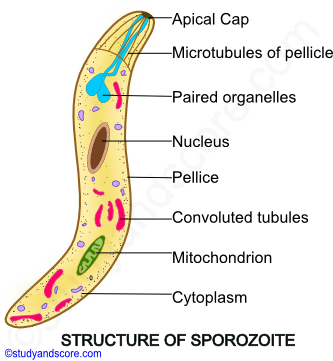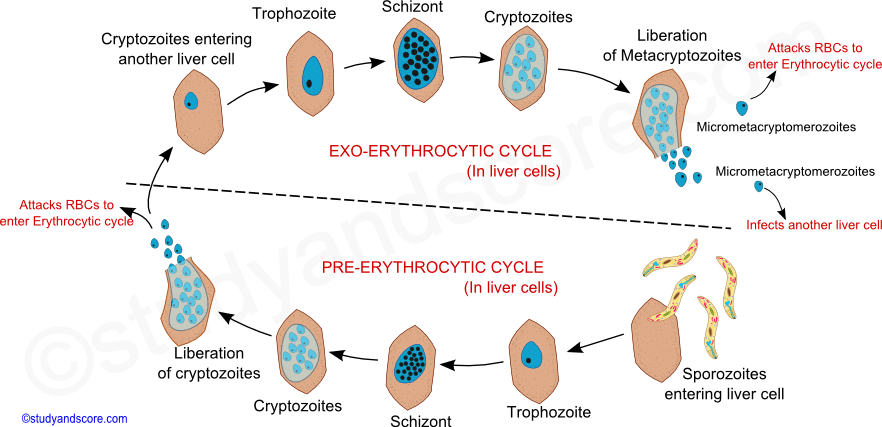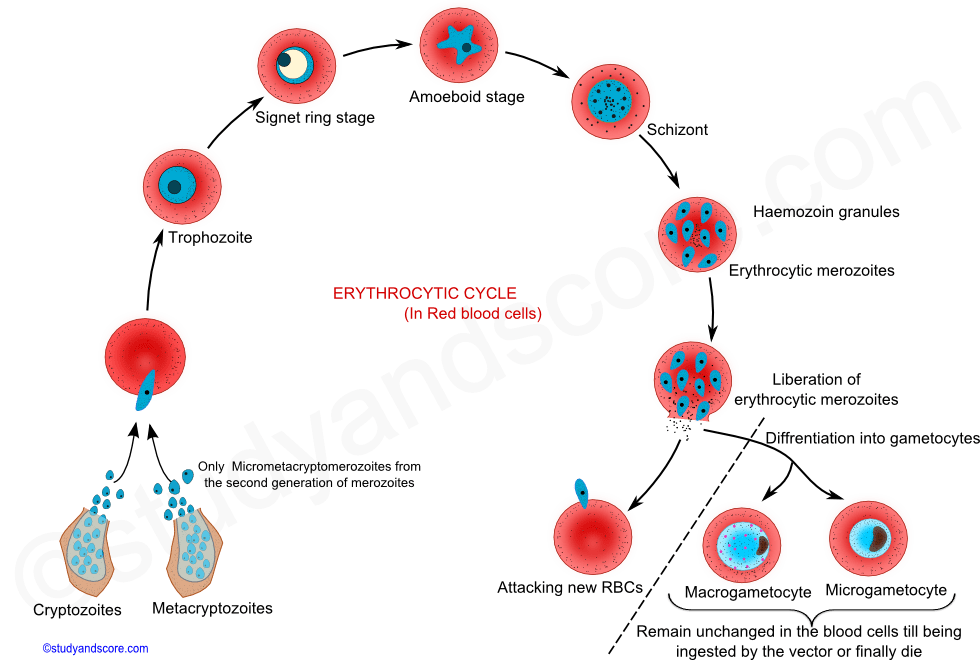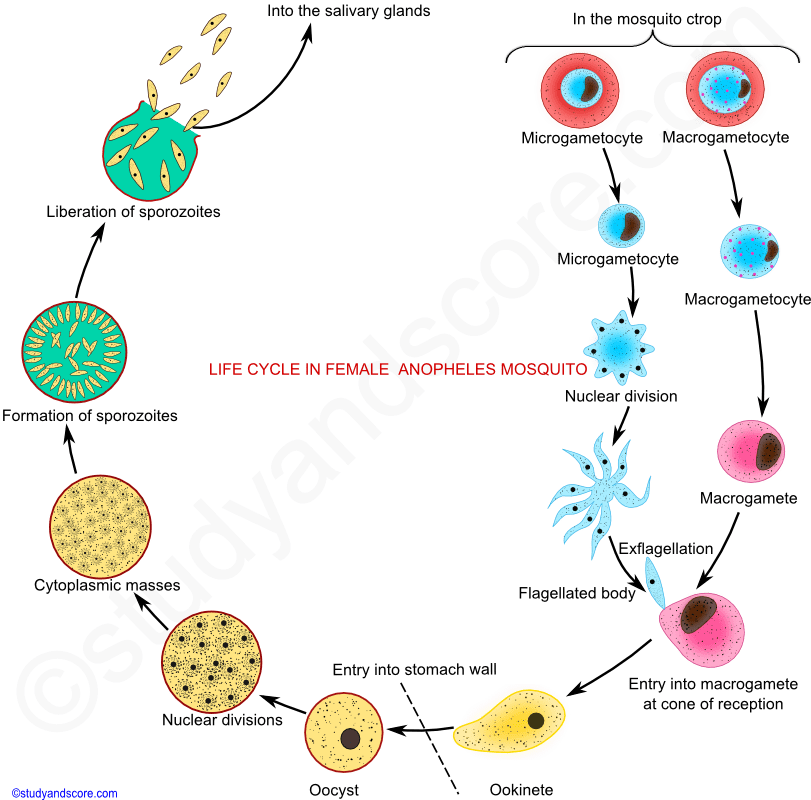Plasmodium vivax, plasmodium ovale, plasmodium falciparum, and plasmodium malariae are the organisms causing malaria in human beings. Malaria is the most common disease of man. In olden days it was believed that malaria is caused due to the bad air or the harmful vapors produced in the marshy lands. The word malaria is an Italian word meaning mala=bad and aria=air.
For the first time, in 1860, Laveran, a French doctor, observed the Plasmodium in the blood of a malarial patient. Then Golgi, an Italian scientist in 1885 observed Plasmodium in the red blood cells of a malarial patient.
On 20th August 1897, Ronald Ross discovered the oocytes of Plasmodium in the crop-wall of the female Anopheles mosquito. For his work on malaria Ross was awarded Nobel Prize in 1902. Also every year 20th August is celebrated as the Malaria day in recognition of his Work. Ross carried out a major part of his work on malaria in India. Grassi, an Italian professor described the complete life cycle of Plasmodium vivax in female Anopheles mosquito.
The infective stage of the malarial parasite, Plasmodium to man is called Sporozoite. The sporozoites are spindle shaped with swollen middle part and slightly pointed ends. It measures about 15 µ in length and 1µ in width. Externally the body of plasmodium is covered by a three layered pellicle which is elastic in nature. It contains longitudinally arranged hollow microtubules. These tubules are contractile in nature and help the parasite in its wriggling movement.

At the anterior end a cup like depression called the apical sucker is present. In to this apical sucker, opens a pair of narrow secretory organelles called rhoptries. These secretory organelles secrete cytolytic enzymes which help in penetration of the parasite in to the liver cells. Numerous convoluted tubules are scattered throughout the body of sporozoite.
The life cycle of plasmodium includes two phases, namely asexual and sexual which are completed in two different hosts. The sexual phase of the life cycle is completed in the female Anopheles mosquito and the asexual phase is completed in human beings. Female Anopheles mosquito is considered as the definitive host or invertebrate host whereas humans are considered as the intermediate hosts or vertebrate hosts. Mosquito is also called as the vector as it transmits the parasite from one person to another. Monkey is the reservoir host. In the life cycle of the plasmodium the asexual life cycle alternates with the sexual life cycle. This phenomenon is called as alternation of generations.
Plasmodium vivax reproduces by asexual multiple fission called as schizogony in the liver cells (Hepatocytes) and the red blood cells (Erythrocytes) of humans. The two stages in the human phase are exoerythrocytic stage and erythrocytic stage. In the liver cells two generations are produced-the earlier generation is called as the preerythrocytic generation and all the later generations are called as exoerythrocytic generations.
Exoerythrocytic phase: Sporozoites which are infective stages to man enter into the blood of humans with the bite of the infective mosquito. Within half-an hour these sporozoites enter the hepatocytes. After entering the hepatocytes they are transformed into trophozoites. These trophozoites feed on the on the infected cells and grow in size.

The nucleus of the trophozoite divides several times and the parasite now becomes a multinucleated schizont. Then the division of the cytoplasm of the schizont takes place forming large number of cryptozoites or first generation merozoites. After the formation of cryptozoites the liver cell and the cell membrane of the schizont break open to release all these cryptozoites into the liver sinusoids. These cryptozoites may either enter the red blood cells to continue erythrocytic phase or may again invade liver cells to produce second generation of merozoites.
If the cryptozoites enter the liver cell again it gets transformed into trophozoite and feeds on the infected liver cells. The nucleus of the trophozoite divides several times and the parasite becomes a multinucleated schizont. Then the cytoplasm divides, releasing large number of metacryptozoites or second generation of merozoites into the liver sinusoids by breaking the liver cell and the cell membrane of the schizont.
On the basis of the size the metacryptozoites are differentiated into bigger macrometacryptozoites and the smaller micrometacryptozoites. Now the micrometacryptozoites infect the erythrocytes to get into erythrocytic phase whereas the macrometacryptozoites infect other liver cells to produce one more generation of metacryptozoites.
The time interval between the initial infection by the sporozoites and the first appearance of the parasites in the blood of the infected man is called as prepatent period. The prepatent period is about eight days in case of plasmodium vivax. During this prepatent period the parasite increases in number and the host do not exhibit any symptoms of the disease.
Erythrocytic phase: This phase is also known as Golgi cycle in recognition of the scientist who discovered it. The entry of cryptozoites of the preerythrocytic generation or the metacryptozoites of the exoerythrocytic generation into the erythrocytes marks the beginning of erythrocytic phase.
As the name suggests this phase takes place in the red blood cells or the erythrocytes of humans. These merozoites get transformed into trophozoites after entering the RBCs. The earliest trophozoite has a central vacuole which increases in size pushing the cytoplasm and the nucleus to the periphery. This stage is called as signet ring stage as it gives the appearance of a ring.

The parasite in the signet ring stage develops pseudopodia and becomes amoeboid. This amoeboid stage feeds on the contents of the RBC. At this stage the infected erythrocyte grows almost double in size. This phenomenon of the growth of the RBC is called as hypertrophy. This infected RBCs become pale in color due to the loss of hemoglobin. Minute red-staining granules called schuffner’s dots appear in the cytoplasm of the RBC. These schuffner dots are the antigens excreted by the parasite.
The fully grown trophozoite fills the entire erythrocyte and becomes schizont. It undergoes erythrocytic schizogony. The nucleus divides by multiple fissions and each bit of the nucleus is surrounded by a mass of cytoplasm to form the erythrocytic merozoites.
In this cycle the parasite feeds on the hemoglobin of the RBCs. The ingested hemoglobin is broken down into globin and haematin. The digested haematin forms the characteristic brown colored haemozoin granules which are toxic and are the main cause of malaria.
In the infection caused by Plasmodium vivax, haemozoin is released into the blood every 48 hours along with merozoites after the completion of erythrocytic cycle. Also fever occurs every third day. Such a type of fever is called a tertian fever.
The time interval between the entry of sporozoites into the body and the onset of the disease is called incubation period. Incubation is about 10-14 days in case of Plasmodium vivax.
Gametogony: Some merozoites, after the completion of few erythrocytic schizogony cycles, develop into sexually differential forms called gametocytes instead of forming schizonts. The formation of gametocytes takes place in the bone marrow and spleen. After the formation the gametocytes appear in the blood circulation. They are generally of two types,
* Macrogametocytes: They are larger, female gametocytes with small nucleus. Their cytoplasm is loaded with food materials.
* Microgametocytes: They are smaller, male gametocytes with large nucleus. Their cytoplasm is clear. Comparably they are more in number.
The gametocytes remain unchanged in human blood waiting for a female Anopheles mosquito to bite. They remain so in the human blood for about a week after which they degenerate. Further development of the gametocytes to gametes can occur only in the crop wall of the mosquito.
The life cycle of the plasmodium in mosquito is called Ross cycle, in recognition of the work done by Sir Ronald Ross. When a female Anopheles mosquito bites an infected human, the gametocyte stages present in the blood of the infected human enters the mosquito. Only the gametocytes present in the blood survive the digestive action in the crop of mosquito and all the other stages are digested. The pH of the digestive fluid and the body temperature of the mosquito are favorable factors for further development of the gametocytes.

The life cycle of the plasmodium in mosquito includes the following events:
Formation of Gametes: During the formation of the gametes, the microgametocytes become very active and its nucleus divides into eight daughter nuclei, then eight flagella like process of the cytoplasm appear on its surface. This stage is called as flagellated body. Each nucleus passes into each of these cytoplasmic extensions and forms a microgamete or male gamete. These microgametes through their beating movement get themselves liberated from the flagellated body as male gametes. This process of formation of the male gametes is called as exflagellation.
On the other hand, the macrogametocytes do not undergo any division but get matured into female gametes or macrogametes. The nucleus moves towards the periphery and the cytoplasm is projected at that point. This projection point is called as the reception cone or fertilization cone.
Fertilization: The male gametes which move about with their beating movement get in contact with the reception cone of the female gamete and enter into it. The pronucleus of the microgametes fuses with the pronucleus of the macrogamete. As the gametes which are fusing are dissimilar in form, this fusion is called as anisogamy. It results in the formation of a spherical zygote.
Formation of sporozoites: The zygote thus formed after the process of fertilization remains inactive for some time and then becomes elongated, motile vermiform. At this stage it is called as ookinete. It pierces into the wall of the crop and comes to lie beneath the basement membrane. It becomes round and secretes an elastic cyst wall around it. This encysted zygote is called as oocyst.
The oocyst enlarges in size and begins multiplication by the process called sporogony. The nucleus first undergoes reduction and then it undergoes repeated mitotic divisions to produce a number of nuclei. The oocyst develops large vacuole which divides the cytoplasm into bits. Each bit of nucleus is surrounded by a bit of cytoplasm and these structures are called as sporoblasts. The cysts containing the sporoblasts are called as sporocysts. This multiple fission in mosquito is called as sporogony. Sporoblasts are formed into thousands of spindle shaped sporozoites. Cysts burst out and sporozoites are liberated from the cyst into the haemocoel. The life cycle in mosquito is completed in 10-24 hours depending on the temperature ambience.
The sporozoites thus formed are motile and they reach the salivary glands of the mosquito. Now they are ready to be injected into a new host. These sporozoites enter the human blood along with the saliva of the biting female Anopheles mosquito.
Pathogenicity of Plasmodium
Plasmodium vivax causes benign tertian malaria which is less dangerous form of this disease. The clinical features of malaria include, febrile paroxysm (spells of fever) followed by anemia and enlargement of spleen. A febrile paroxysm includes three stages,
In some cases relapse of malaria disease takes place when some stages of the plasmodium remain dormant for a longer duration in liver. These dormant forms are called as hypnozoites. These hypnozoites may get reactivated in course of time leading to initiation of fresh erythrocytic cycle and new attack of malaria.
Preventive measures and prophylaxis
Malaria can be controlled by the following methods,
Protection against mosquitoes:
Destruction of mosquito larvae:
| Characters | P. vivax | P. malaria | P. ovale | P. falciparum |
|---|---|---|---|---|
| Distribution | Worldwide | Worldwide | Tropical Africa | Worldwide |
| Duration of pre-erythrocyic cycle | 8 days | 7-12 days | 9 days | 5-6 days |
| Merozoites per schizont | 10,000 | 2,000 | 15,000 | 40,000 |
| Duration of erythrocytic cycle | 48 hours | 72 hours | 48 hours | 36-48 hours |
| Merozoites per schizont | 12-24 | 6-10 | 6-12 | 18-24 |
| Incubation period | 14 days | 18-24 days | 14 days | 12 days |
| Gametocytes in RBC | Round, fully fills RBC, pigment granules evenly distributed | round/oval, fully fills RBC, Pigment granules in centre | Round/oval, fills ¾ of RBC, pigment granules evenly distributed | Crescent shape, pigment granules only around the nucleus |
| Host RBC | Enlarged and red schuffner's dots are seen | Not enlarged and Zeimann's dota are seen | Slightly enlarges and red schuffner's dots are seen | Not enlarged and green Maurer's dots are seen |
| Haemozoin pigment | Yellowish brown fine granules | Dark brown coarse granules | Dark brown coarse granules | Dark brown coarse granules |
| No. of microgametes | 4-8 | 2-5 | - | 4-8 |
| Duration of sexual cycle | 10 days | 25-28 days | 16 days | 10-12 days |
| Types of malaria | Benign malaria | Quartan malaria | Tertiary malaria | Malignant malaria |
| Effects of malaria | Low death rate | Severe | Mild | High death rate |

- Share with your friends! -

Mahima Tyagi on Apr 17, 2020 at 02:32 pm
Can you please suggest the book from where you took such good content ....I want the content About AIDS TB and Cholera as these also comes in upsc ..... Please reply sir
Login to post your comment here...
- or with social Account -